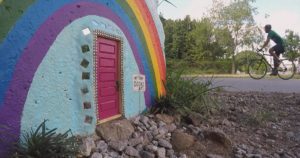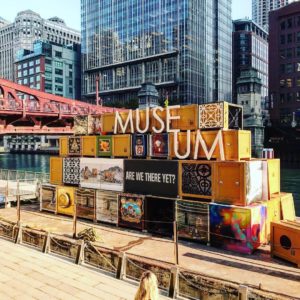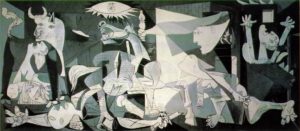Public art means connected art!
Category: Visual art
Now Is the Time For Real Change
In past posts, we’ve noted the many ways artists speak out through their art-doing. Whether to question or connect us, artists are charged, perhaps now more than ever. And thanks to social media, more and more people can engage with the good work artists do.
For example, to memorialize and respond to the atrocities that ended the life of George Floyd – as well as re-ignite #BlackLivesMatter and speak to the hundreds of years of Black persecution in the United States – visual artists have taken to the streets in the ways they know best. Greta McLain, Xena Goldman, and Cadex Herrera acted by painting a mural at the corner of 38th Street and Chicago Avenue South, the spot where Floyd was arrested. These three artists were assisted by artists Maria Javier, Rachel Breen, Niko Alexander, and Pablo Helmp Hernandez.
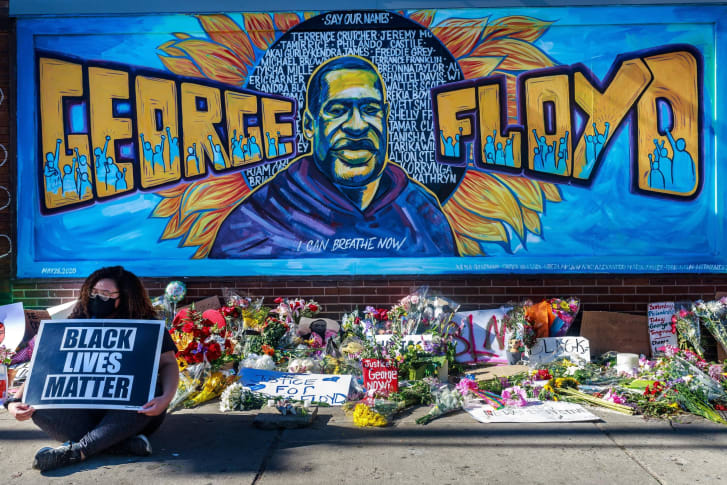
Minutes before his death, Floyd managed to muster: “I can’t breathe.”
Floyd’s last words, “I can’t breathe,” were transformed and the phrase at the center of the mural came later. As stated by one of the muralists:
Beyond Minneapolis, many more murals have emerged around the globe.
Visual artists are not the only ones speaking out. Poets, filmmakers, actors, and more are outraged.
Musicians, too, regardless of genre are expressing their frustration, sadness, and empathy.
The above are just a small sample of the artists who are speaking out against injustice. Let us join them.
Amidst the Chaos, the Arts Provide Connectivity
Physicians, social media, and social psychologists are saying that, if at all possible, social distancing does not necessarily mean emotional distancing.
With this in mind, artists of all kinds have been doing their uplifiting “good work”—i.e., mobilizing their artistic citizenship or “artivism”—by putting the arts to work for emotional and psychological well-being.
Indeed, while concert halls, school auditoriums, museums, galleries, clubs, and other places of/for artistic experiences are closed, many musical, visual and other kinds of artists across the nation and around the world are going online and taking to the streets.
Diplo is live streaming DJ sets from his home five times a week on YouTube. The shows run Sundays, Tuesdays, Thursdays, Fridays, and Saturdays, with distinct themes each day. Paul Simon and Lukas Nelson & Promise Of The Real are “coming together” on Twitter through #selfdistancetogether
When the times call for social distancing, cellists of the New York Philharmonic respond with J.S. Bach’s Suite No. 1 for Unaccompanied Cello in G major. I: Prelude, Nathan Vickery II: Allemande, Principal Cello Carter Brey III: Courante, Sumire Kudo IV: Sarabande, Alexei Yupanqui Gonzales V: Menuets I and II, Eric Bartlett VI: Gigue, Maria Kitsopoulos
The above-mentioned do not provide monetary comfort for those producing the art nor those experiencing it. Alongside many newly-found unemployed persons, artists and arts-takers are not immune to financial loss despite the Internet’s outlets and potentialities.
As reported in The Guardian, some visual artists are taking to the streets.
These artists are not benefiting financially for their efforts, and neither are people who are experiencing these performances. Obviously, unemployed people, including art-makers and audiences, are not immune to financial loss.
Still, we must say “thank you” to all the artists across genres and practices who find the perseverance and courage to continue doing what they do. In fact, we might be more accurate and honest if we ask: Where would we be right now without the arts? And: How might we feel if artists—whether professional or amateur—failed to provide us with ways and means of/for connecting?
Doors and More
What do “doors” do? On one hand, a door might, especially if it’s locked, keep people outside an “insider’s” domain. On the other hand, a door invites people to enter. One knock on a closed door, and two reactions are possible: An inviting voice from the other side might say, “Come in; it’s open.” Or, after being knocked upon, and within moments of waiting, the door may open and a person on the other side potentially could ask: “Can I help you?”
Meet the public art project, #TinydoorsATL.
In 2014, Karen Anderson and Sarah Meng started to introduce these “entrances” in public spaces. Notably, the doors provide access to an imaginary world. Moreover, and provided an onlooker doesn’t miss a potential voyage into the unknown – indeed, it is easy not to notice the doorways given their locations, and sometimes hidden positions – the people of Atlanta can dream-through a portal beyond the here and now.
As stated on the project’s website:
Tiny Doors ATL is an Atlanta-based art project bringing big wonder to tiny spaces. Our constantly evolving installation pieces are an interactive part of their community. With the installation of a door, what was once a wall or the column of a bridge becomes an entrance to collective creativity and an invitation to whimsy. Tiny Doors ATL is dedicated to free and accessible art.
The doors, themselves, are about 7-inches tall, and are located in places in and around Atlanta, Georgia.
According to the principal artist and director, Karen Anderson:
Much of what I’d hoped to see from this project is happening organically. For instance, I’d hoped that our doors would be tiny gathering places, landmarks for people to leave free art for #FAFATL, take creative photos, and get to know other areas of town by encouraging exploration to new neighborhoods. My big goals for the project include tying together communities, and eventually creating a full-time position with Tiny Doors ATL so that I can do the outreach to schools and camps that we’re being asked to provide. I’m also doing some consulting with other cities on their tiny public art movements.
A door can provide us with a sense of possibility. Such optimism and hope is a gift not to be taken lightly.
#iamFOR
According to artist Paula Crown, the #iamFOR exhibition on display at the For Freedoms headquarters incorporates, examines, and explores themes of environmentalism, racial awareness, and identity politics.
Located in the heart of the Meatpacking District in NYC, onlookers are provocatively greeted by and confronted with Crown’s environmentally probing piece, Humble Hubris: Don’t know what you got (till its gone) bench (2018), outside Fort Gansevoort, at 51 Gansevoort Street, NYC: “If you think you’re hot now, just wait.”

This statement, especially given its location—which is surrounded by all kinds of NYC construction—makes obvious the tangled mess of urbanization, commercialization, and industrialization. Notice, too, how Crown’s piece is juxtaposed with the seemingly dead vines clinging to the lattice work outside the edifice and the winding coils of cables adjoined to the outlet in back of the artwork. What does all this mean?
Additionally, situated in the window just around the corner from Humble Hurbis are Not banners (2018). As stated by the exhibit:
In the 18thcentury, anthropologists and cartographers created hierarchies and vocabularies that continue to haunt us, labeling the world with colonial perceptions of human difference. Classification of human beings by color is a social construct dismantled by scientific truth. Artist Paula Crown’s NOT paintings prompt viewers to compare themselves with the subjective taxonomies of the past, to invalidate prior modes of categorization and to demand nuance and agency.
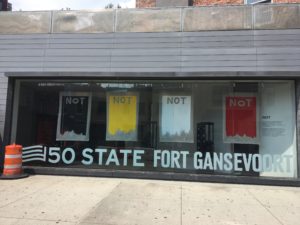
Moreover, it is worth noting that one of the construction signs posted next to Fort Gansevoort, and catty-corner to the Not banners, is a call for vehicles to “use alternate” means of maneuvering through the area. Of course, neither the For Freedoms group, nor Crown, would have expected this kind of coincidence. That is, it is provocative that NYC is asking motorists for “caution” and to take alternative traffic routes when Crown invites her artwork visitors to reconsider the routes they use to move through the world!
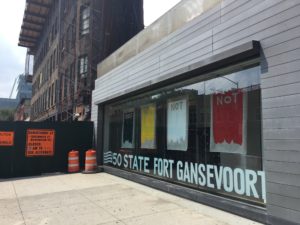
There’s much more to the #iamFOR exhibition. If you happen to be in NYC, be sure to experience it for yourself.
London’s Fourth Plinth
For those who may not know, London’s Fourth Plinth is located in Trafalgar Square. The other three plinths, or platforms, contain sculptures of military officers: Henry Havelock, Charles James Napier, and King George IV. However, the fourth remained empty due to a lack of funding, unused for 150 years. That is until London’s Royal Society of the Arts developed the Fourth Plinth Project. The project maintains a revolving public art exhibit in order to celebrate, question, and engage with the world today through art-making. In fact, the Fourth Plinth hosts a series of commissioned artworks by world class artists and is the most talked about contemporary art prize in the UK.
So, what is on exhibit now?
On March 28th, Michael Rakowitz’s “The Enemy Should Not Exist,” was unveiled. The work “depicts a re-creation of Lamassu, an Assyrian statue that stood in Iraq in the ancient city of Nineveh, on the outskirts of modern-day Mosul, until 2015 when the militant group destroyed it along with other irreplaceable works of ancient art.” The work is made of 10,500 recycled cans of syrup made from dates (dates being an important export of Iraq).
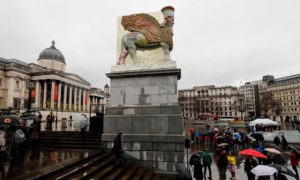
Mayor of London, Sadiq Khan, stated: “One of the reasons we should be so proud is this piece of art is from an Iraqi American of Jewish faith to be displayed in the greatest city in the world … And the creation and installation of this piece of art is an act of resistance against the tyranny of religious fanaticism. It is an act of resistance against the acts of philistinism. But it is also a celebration of who we are as a city: confident in who we are, pluralistic, welcoming and diverse.”
From London: Artists as Citizens
Just returned from the “Reflective Conservatoire Conference: Artists as Citizens.” This inspiring, 4-day conference showcased, among other things, a variety of arts projects that illustrate how the arts do their good work.
In doing so, the conference asked the essential and age-old question: What do artists do? Undoubtedly, artists view the world in unique ways. And, through their artwork, help us confront our realities—the good, the bad, and the ugly. Thus, at the heart of this kind of work is the concept of “artistic citizenship” and being an “artist-as-citizen.”
Meet one artistic citizen: Helen Marriage. Director of “Artichoke,” Marriage stays clear of traditional “artistic spaces”— the gallery, concert hall, theater or dance studio—and instead transforms the streets, squares, gardens and coastlines of the public spaces around the UK.
In her talk, “Beyond the institution: Working the streets,” Marriage spoke about disrupting public spaces “with an objective to work with artists to create extraordinary, large-scale events that appeal to the widest possible audience.”
At the heart of Marriage’s projects is accessibility and equity, and the notion that all people have the right to experience artwork for free.
One such project was Great Fire 350, dedicated to commemorate the 350th anniversary of the London fire of 1666.
While this project, one among many, speaks for itself, a few aspects deserve special mentioning. Throughout 2016, London marked a season of exhibitions, concerts, lectures, and tours. A festival, really, of the power of the arts to provoke the imagination, Great Fire 350 included an underwater performance art-work, a domino-esque sculpture that snaked throughout London’s streets, which outlined the various roadways of the 1666 fire, and ended with a live re-burning of a model of 1666 London on the Thames River. This grandiose festival implied numerous aspects about social life. Primarily, though, Great Fire 350 highlighted a beautiful and powerful resilience of a city and its peoples to be re-born.
Chicago’s Floating Museum
How can art transform a landscape? And who have access to such transformation? The River Assembly Project not only confirms that art has the power to transform, but also declares that each and all should have access to art’s potentials.
Turning an industrial barge into The Floating Museum, Chicago’s local artists, with various arts and cultural organizations, came together to “create temporary, site-responsive museum spaces to activate sites of cultural potential throughout Chicago’s neighborhoods.”
According to the creators of the project, first it’s important to talk “with community leaders, organizations, and artists who are deeply invested in their neighborhood.” Then they “nurture new connections between communities, institutions, and the people these spaces serve.” The results of this process are “installations are platforms for engaging communities and celebrating the art and culture being produced by our neighborhoods.” In doing so, The River Assembly Project “bring[s] together the work of … dispersed locations in a traveling museum that celebrates the energy” of Chicago.
The Floating Museum showcases visual arts, media, and performances by more than 30 local and national artists, including:
Miguel Aguilar (aka Kane One), Tiaybe Bledsoe, Marcus Alleyne, Hebru Brantley, Marcus Davis, Asia Delores, Bill Douglas, Louis DeMarco, Kameco Dodd, Marcus Evans, Assaf Evron, Krista Franklin, Maria Gaspar, Tracie D. Hall, Jeff Harris, Adam Hines, Jeremiah Hulsebos-Spofford, Yashua Klos, Gaby Ibarra, Kopano (performance), Faheem Majeed, Christopher Meerdo, Ciera Missick, Cecil McDonald Jr, Jesse McLean, MonAerie (performance), Derek Moore, Dan Peterman, Cheryl Pope, Pope.L, Fernando Ramirez, Kameelah Janan Rasheed, Cauleen Smith, Sheila Smith, Edra Soto, Lan Tuazon, Maria Villarreal, Roman Villarreal, JGV/WAR (J. Gibran Villalobos & Wil A. Ruggiero), Amanda Williams, Bernard Williams, Avery R. Young & De Deacon Board (performance)
For Freedoms
The heart of Artistic Citizenship asks artists of all kinds, whether amateur or professional and across all arts domains, to ask critically important questions, such as:
What responsibilities do artists have to engage in art work for social transformation?
One organization—or, “super PAC” as they call themselves—aptly named “For Freedoms,” not only interrogates this question, but also activates this question for those whom engage with their artistry. As Celia McGee writes:
Founded by Hank Willis Thomas, a photographer and conceptual artist, and Eric Gottesman, a video artist and activist, the super PAC is named after Franklin D. Roosevelt’s “Four Freedoms” wartime address in 1941 — a call to safeguard the freedoms of speech and worship, the freedom from want, and the freedom from fear.
Contributing artists and photographers include Carrie Mae Weems, Rashid Johnson, Xaviera Simmons, Alec Soth, Bayeté Ross Smith, Fred Tomaselli and Marilyn Minter. Their works will be used for billboards, building signs, subway advertising, Internet memes, social media and select print advertising, potentially even yard signs, and ultimately an art show at the Jack Shainman Gallery in Chelsea.
For Freedoms describes their mission as follows:
As the first artist-run super PAC, For Freedoms uses art to inspire deeper political engagement for citizens who want to have a greater impact on the American political landscape.
WE BELIEVE
We believe that artists, and art, play an important role in galvanizing our society to do better. We are frustrated with a system in which money, divisiveness, and a general lack of truth-telling have stifled complex conversation. We created the first artist-run super Pac because we believe it’s time for artists to become more involved in the political process.
What can we learn about the role of art in politics from For Freedoms? We leave this up to you to decide. For now, we urge you to think-through today through the lens of the actions and activism of For Freedoms.
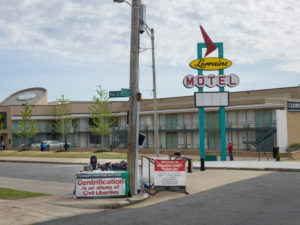
Why the Arts Matter
What happens to us when we actively engage as art-makers or art-takers? Who do we become?
Given the complexities of today’s political, social, and emotional landscapes, engaging with/through the arts is as important now more than ever. Why? “With everything that’s going on in the world, it’s easy to question the value of telling stories or making sculptures.” While some may be tempted to question the arts at times like these, we disagree. And so does Miguel Syjuco.
“Silence, it is said, implies complicity. But that’s only half the story. Silence also confirms oppression, because the ability to speak out is too often a luxury of the privileged.
The aggressive populism we see today seems to be a testament to people refusing to be silent – and rightly so. Our societies have largely failed to provide equally for all, and technology now gives us new avenues through which to be heard, and with which to rebel against repressive ideas and structures. New leaders have latched onto that and now seek to speak for us, even though many of them are rallying us crudely around fear and mistrust.”
